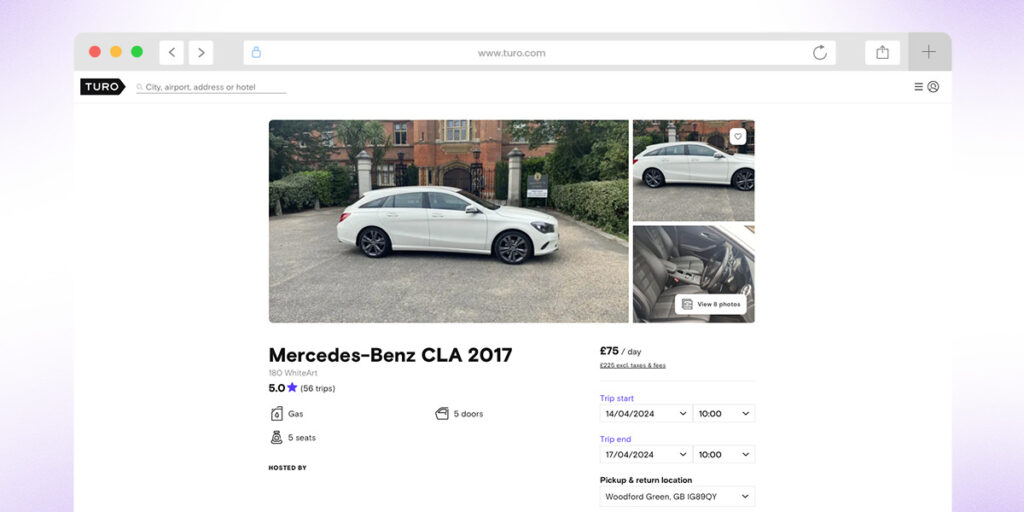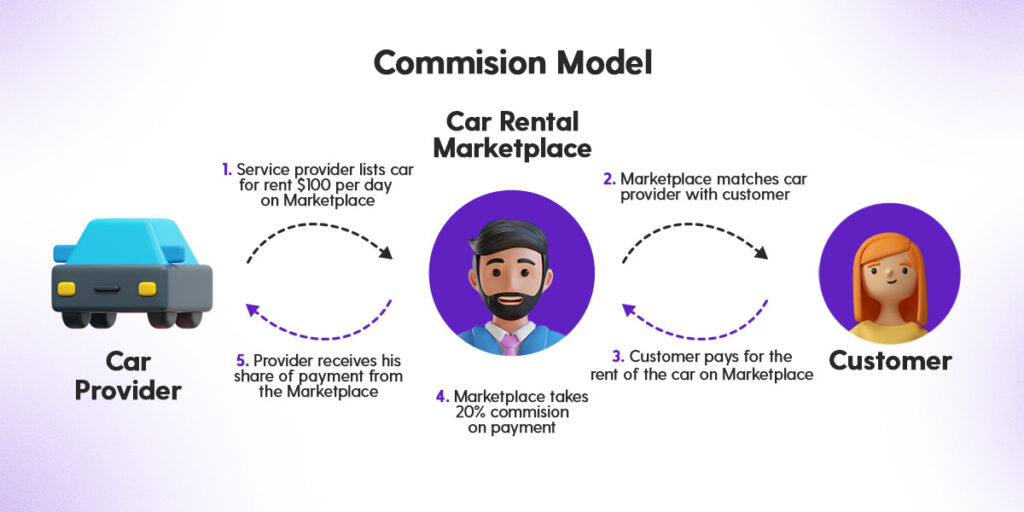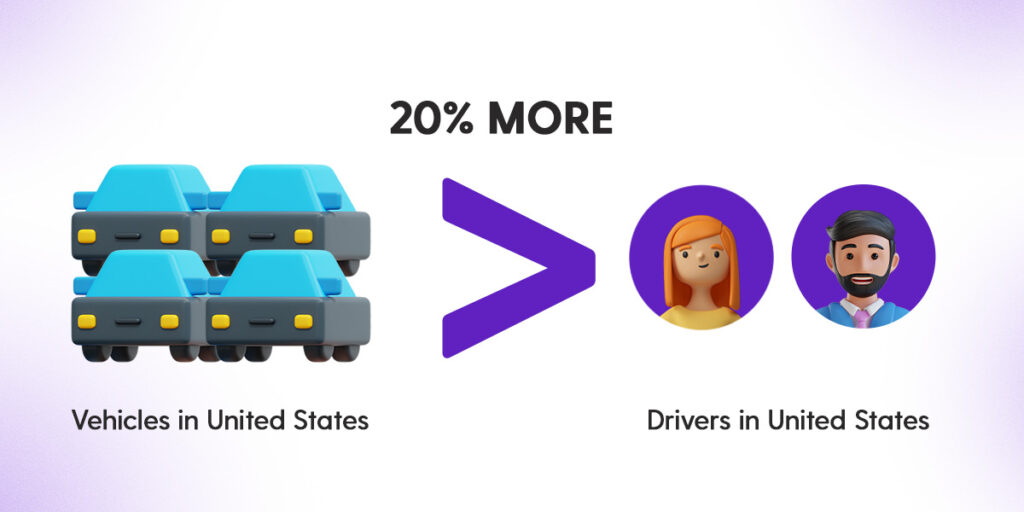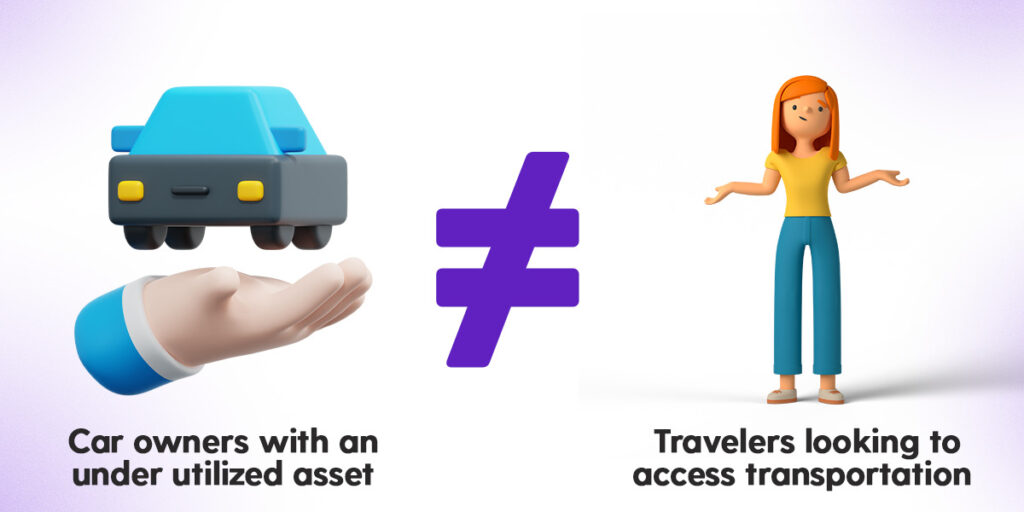Turo is a peer to peer marketplace for car rentals based in California, United States.
In this article we break down Turo’s business model, how they make money, their key marketing and sales channels as well as their main operating costs and competitors.
What is Turo?
In non-technical terms, Turo is the Airbnb of car rentals. In more technical terms Turo is a location based, peer-to-peer, car rental marketplace.
- Location based means that the customer must be in the same location as the listing in order to complete the order.
- Peer to peer (p2p) describes how Turo’s main users interact. On a p2p marketplace, the main users are private individuals; they can be car owners, car renters or both.
- Car rental marketplace describes the type of asset that is offered on the marketplace. Rental marketplaces can be for any different type of asset from land, homes, studio space to furniture and taxis. Notice that a rental marketplace has a different set of features compared to a product or service marketplace like Amazon or Upwork.
Now that we know what Turo is, let’s take a brief look at how Turo started.
A brief history of Turo
Turo was founded by Shelby Clark in 2009 when Shelby was living in Boston Massachusetts.
Despite living in Boston, Shelby originally launched the platform in Baltimore because this was a city that didn’t have any car sharing alternative. He started by developing a very basic website that allowed car owners to upload their cars. He then printed out 10,000 flyers and took to the streets of Baltimore trying to convince car owners to upload their cars onto his site. As he explains, the results were very polarizing. Some people were immediately willing to upload their cars, others were not.
After this initial launch in Baltimore, Shelby had 40 cars uploaded onto his website. The next step for him was to build up the demand side of Turo’s car rental marketplace and ensure his initial supply of cars didn’t churn. This was not straightforward and it took many years of product and marketing iteration, a change in CEO and several significant investments to achieve.
To learn more about the history of Turo read, how to build a car rental website like Turo.
Turo’s business model - How Turo makes money
Let’s take a deeper look at Turo’s business model to investigate how Turo makes money.
How Turo works
As we have seen, Turo is a peer to peer rental marketplace for cars. The platform allows car owners to login to the marketplace, upload information about their cars and list their cars.
Travellers in need of a car can then browse through lists of cars to rent, select a vehicle that best matches their needs and then book to reserve the car through Turo’s website. Money is exchanged between the car owner and the car renter via the Turo platform. Below is an example of a listing on Turo.

How Turo makes money - the commission model
Turo’s business model is simple to understand.
The platform charges a commission fee whenever a car is rented on their marketplace. For instance, let’s suppose you want to rent out the Jeep Wrangler Unlimited 2021 for an adventure. The cost of this car is $100 per day and you want to rent it out for 5 days, this is a total of $500.
When you make the payment, the money gets passed to Turo who will deduct a percentage commission, say 20%, before passing the money through to the car owner.

In reality, Turo charges a variable commission that ranges from 15% – 45% based on various factors such as vehicle type, duration of the rental, demand, location, and additional services. All that being said, the average commission is usually no more than 25%.
There are many different marketplace business models that you can use when building a marketplace like Turo. Each of these business models can be used to give your marketplace a unique selling point vs the competition.
Turo’s value proposition
Turo’s business model allows them to charge a commission for car owners and renters. This is because Turo provides a significant value to those users. You can think of this Turo’s value proposition as follows.
In the United States there are 20% more cars than drivers. This means that there are millions of under utilized vehicles in the United States.

When a vehicle is not being used fully, this leads to unnecessary costs for the car owner such as vehicle upkeep, depreciating value, insurance and so on. Turo’s marketplace solves these problems by utilizing the peer to peer marketplace model. In this model Turo connects car owners with travellers looking to rent out transportation for a short period of time.

Of course, travellers could also look on alternative platforms such as Facebook Marketplace, contact car owners directly and rent from them; however, Turo provides more than just a list of cars. The platform also offers travellers:
- A wide variety of cars at a range of prices
- A simple renting experience where travellers can quickly choose a vehicle, agree on a price, period and mileage and then pick up the vehicle at an agreed location.
Meanwhile, Turo offers car owners:
- An active market of travellers looking to rent out their cars
- Flexible scheduling options to set availability according to their preferences
- Insurance coverage for both owners and renters of up to $750,000, ensuring peace of mind during rentals
- Detailed profiles and reviews to showcase their vehicles and build trust with potential renters
- Access to a large and diverse pool of renters, maximizing the potential for bookings
- Support and assistance from Turo’s customer service team throughout the rental process.
Turo’s marketing channels
Turo’s marketing channels have evolved over time, based on their target audience.
In the early days of the company, Turo was focused on a city by city approach. This means that their marketing campaigns were localized to particular cities where they focused on marketing their platform as a solution to run quick errards. However, this approach to marketing failed to bring in clientele with a high enough lifetime value vs the cost required to find the client i.e. it may have cost Turo $1000 to find a client, but the client would only spend $500 on Turo over their entire lifetime. As such, the platform was struggling to survive.
In 2011 the board of directors and shareholders decided to bring in a new CEO, Andre Haddad. Andre changed the approach to be nationwide and focused on a target audience that wanted to book cars for a minimum of 1 day. Using this approach Andre implemented the following marketing channels at Turo.
- Investment in the online website, making it more discoverable by search engines.
- Paid advertising in the app store
- Social media e.g. Facebook (Meta) and Instagram
- Billboards, busses and transit ads e.g. in Manhattan
- TV and Video streaming
Below is an example of a billboard advertising campaign run by Turo in downtown New York.

For more information on Turo’s change in business strategy read how to build a car rental website like Turo.
Turo’s cost structure
Turo’s business model requires them to spend money in the following areas.
- Website and app development
- Marketing and branding
- Insurance coverage
- Payments
- Research and development
- Operating costs
Let’s take a quick look at each of these areas and what is included in each now.
1. Website and app development
Turo makes ongoing investment into their website and app to both develop new and maintain existing features.
Feature development is important because it ensure that the platform remains competitive. For example, in 2023, Turo introduced a new feature called “instant booking” that streamlines the booking process. The introduction of this feature increased the number of bookings on their platform.
Meanwhile, Turo must invest in maintenance to keep the platform compliant with changes in regulation and third party technology upgrades. Furthermore, with constant upgrades being pushed into Turo’s core code base, bug fixing is an ongoing process in all technology companies.
2. Marketing and branding
As companies grow they must continue to optimize their marketing funnels and look for ways to keep their customer acquisition costs low, whilst also maximizing repeat business from existing customers. This requires ongoing investment into marketing personal, testing and refining ads campaigns and the development of new content to help promote the brand.
3. Insurance coverage
Turo offers both car owners and drivers insurance coverage on their travels of up to $750,000. Turo also provides 24/7 roadside assistance for all trips booked through their platform. This insurance coverage provides both car owners and drivers with a level of confidence that makes them willing to use Turo as an intermediary.
In order to provide this insurance coverage, Turo must continually pay insurance providers to give them coverage and also, work with insurance providers to make the relevant payouts in the case of an accident.
4. Payments
Like all other online marketplaces, Turo uses a third party payment provider for their payments infrastructure. In Turo’s case, they use a platform called Braintree which is owned by Paypal. Braintree charges Turo a percentage commission in order to make transactions via them.
5. Research and development
Although we don’t know exactly what top secret research and development (R&D) plans Turo is working on, technology companies all conduct R&D. This allows them to innovate and improve their platform, services and technology. Generally speaking, R&D is different from day to day bug fixing and feature maintenance. This is because it is a type of development that explores the unknown.
For example, in 2023 many tech companies invested in looking at artificial intelligence, machine learning, and data analytics to optimize internal operations and cut costs. This type of R&D was particularly prevalent in the area of customer support where companies trained AI systems to provide automated responses to customer support tickets.
6. Operating costs
All businesses have ongoing operating costs such as rent, utilities, wages, customer support, legal fees and so on. For a detailed breakdown of what the operating costs are that Turo incur, you would need to read Turo’s annual reports. However, the Turo is a private company not a public company and therefore, it is not legally required to publicly disclose extensive financial information.
Turo’s key resources
Turo’s business model works because of certain key resources that they have acquired over the years.
The primary resource that Turo has is the development of a two sided marketplace network effect. This has allowed the platform to grow exponentially and is why the solution now has more than 14 million users and over 450,000 vehicles in over 56 countries. To build a two sided marketplace network effect takes years of work and requires the development of a marketplace flywheel effect.
In addition to the network effect, Turo has:
- Car listings and renters
- Software and infrastructure developers
- Customer support
- Brand image, as a pioneer in the car sharing and tourism industry
- Strong investor support
Turo’s competitors
- Uber Rentals: Uber Rentals is the car-sharing service offered by the ride-hailing company Uber. The service debuted in 2019 and does not operate a p2p system but rather works as third-party connecting users to other rental services;
- Getaround: Getaround is an American car-sharing company that operates a peer-to-peer car-sharing service that is quite similar to Turo. It was founded in 2009 and is seen by many as Turo’s closest competitor;
- Zipcar: Zipcar is a car rental service that was launched in 2000 and allows users to choose from the fleet of over 12,000 cars that the company maintains;
- The Hertz Corporation: The Hertz Corporation is one of the oldest and largest car rental services in the world. They offer over 12,000 vehicles and operate as a traditional rental service where customers are allowed access to the vehicles for a fee.
Conclusion: How to build a business model like Turo's
To build a business like Turo, you need to be relentlessly driven. It is not easy to create a company worth more than $1 billion.
All that being said, there are plenty of niche marketplace opportunities out there and with advances in technology, building the tech to support a car rental marketplace has never been easier.
Platform’s such as Dittofi’s hybrid no-code solution allow you to use prebuilt p2p marketplace templates that give you all of the essential features for a marketplace like Turo on day one.
Users can then work within Dittofi’s visual development studio to customize and launch their marketplaces 10x faster than traditional coding, without any vendor lock-in and with 100% flexibility.
If you’d like to discuss how to build a platform like Turo, book a call with one of our marketplace specialists or sign up to Dittofi where you can build an enterprise grade marketplace like Turo using Dittofi’s unique hybrid no-code platform.
Lastly, you can browse some of our other founder stories on the rest of our blog or subscribe to our youtube channel for more updates in the future.
Wishing you the best of luck on your marketplace journey!
Become a Marketplace Insider
Join our inner circle for exclusive insights, coveted trade secrets, and unparalleled strategies – your journey to marketplace dominance begins here.

